
Two images have been taken
(12 mn in R each)
with relatively poor seeing (0.9"-1")
and highly variable transparency.
The GRB is now very faint,
slightly visible above noise
in the center of the picture...
| GRB000926 observations |
October 4 (posted
on October 4)

Two images have been taken (12 mn in R each) with relatively poor seeing (0.9"-1") and highly variable transparency. The GRB is now very faint, slightly visible above noise in the center of the picture... |
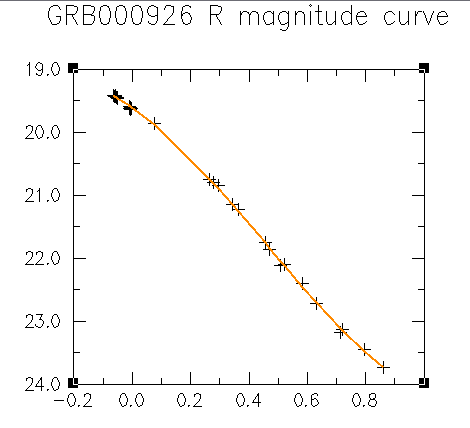
The light with no attempt to fit straight lines
|
GRB000926 - Optical observations
The optical counterpart of GRB000926
has been observed using the
CFH12K CCD mosaic camera at
the prime focus of the 3.6-m CFH
Telescope for the sixth night
on Oct. 4.25 .
The two images were with variable
transparency and poor seeing conditions
(0.9 to 1").
Star 2 (see GCN #830 and the web page referenced
below) is used as a
reference with R=20.36 for the following
photometric data:
Sept. 29.3075
21.23 0.03
30.3075
22.10 0.04
Oct. 1.2593
22.71 0.04
2.2626
23.13 0.08
3.2304
23.45 0.10
4.2500
23.73 0.15
T is in UTC days after Sept. 0 . R magnitudes
are given with their uncertainty.
A photometric check on stars 1 and 2 leads
to mg1 - mg2 = 0.658 +/- 0.01
over the 6 nights of observations.
A graph of the light curve in
R from CFHT observations can be found at
http://www.cfht.hawaii.edu/~veillet/grb.html
as well as the last image of the OT vanishing
in the background...
We are done at CFHT with the
observations of the OT itself. The observing
time used for GRB000926 has
been taken from allocated time to
colleagues from Canada and
Hawaii who are once more acknowledged,
with for last night special
thanks to M. Brodwin.
The field will be imaged again when CFH12K
will be on the telescope for
a final photometric calibration before running
the last analysis and
publishing the data.
This run has been more hectic than the one
on GRB000301C. Sorry for that...
Aloha!
This message may be cited.
October 3 (posted
on October 3)
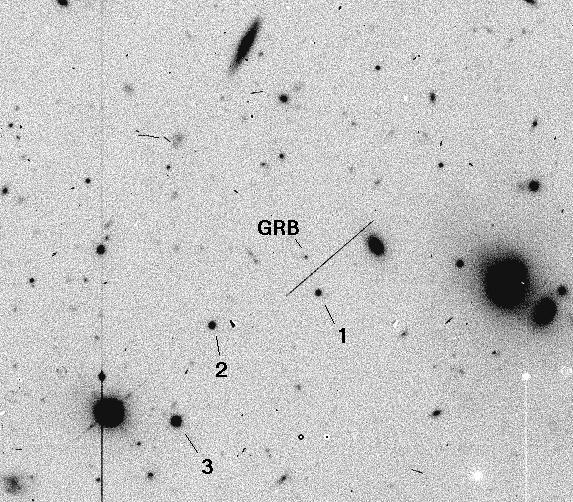
This is the last image taken on Oct. 3.237 UTC
|
As we found a large discrepancy between MDM and CFHT data, I tried to find something wrong in our reduction here.
Information on the CFHT data:
- none of the nights, up to now, have been photometric
- on most of our images with good seeing, the R=17.06 (S) reference
star used by others is saturated
- star 1 magnitude has been estimated from the unique image where S
is not saturated (though not far from being so...)
Thanks to Fredrick J. Vrba at USNO, I got preliminary photometric values for stars 1, 2 and 3 as following:
Star R
1 21.01 +/- .05
2 20.40 .03
3 18.60 .01
where errors are mostly internal, as USNO hasn't got real photometric
nights for acquiring a whole photometric calibration of the field.
From a more accurate photometric reduction of our data (six images all
together), I got the following relative photometry between stars 1 and
2
mg1 - mg2 = 0.0658 +/- 0.01
(Star 3 hasn't been used as it has structure around which could or
couldn't be included depending on the quality of the image.
I then asked Jules Halpern to check what he would get for these three
stars (as MDM has a fully calibrated field), and here is what he found:
1. 20.97
2. 20.36
3. 18.58
from, I guess, a mesurement using the image for which we had the difference
mentioned in GCN #829.
A good photometric reduction of the field is definitely needed...
At this point, it doesn't seem fair to publish magnitudes for our observations
of the GRB as long as there is no real photometric calibration of the field
available.
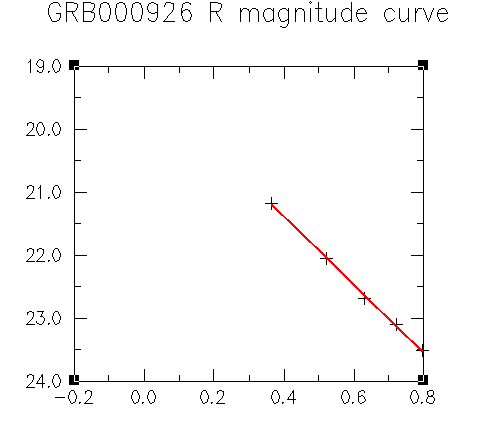
Decay slope is now found as 2.16 +/- 0.03 using
the CFHT data.
|
TITLE: GCN GRB
OBSERVATION REPORT
NUMBER: 830
SUBJECT: GRB000926 - Optical
observations
DATE:
00/10/04 05:10:14 GMT
FROM:
Christian Veillet at CFHT <veillet@cfht.hawaii.edu>
GRB000926 - Optical observations
The optical counterpart of GRB000926
has been observed using the
CFH12K CCD mosaic camera at
the prime focus of the 3.6-m CFH
Telescope for the fifth night
on Oct. 3.2304 .
Following GCN #829 by Halpern
et al., a more accurate reduction of the
CFHT data has been made, with
the problems encountered when none of the
observations is made in photometric
reduction.
A first full reduction of the
images leads to a more constant slope.
The change seen previously
in the decay rate (GCN #825, #826 and #827) doesn't
seem to be real. Even if there
are still discrepancies between the MDM and
CFHT data, there are now smaller,
thanks to the work on the secondary reference
stars made by F. Vrba (USNO).
The 5 nights of observations
at CFHT lead to a decay slope of 2.16 +/- 0.03
but it's not really possible
to link accurately the CFHT magnitudes to others
as long as there is no calibration
of the field stars made.
A graph of the light curve in
R from CFHT observations can be found at
http://www.cfht.hawaii.edu/~veillet/grb.html
where more information on the
photometric reductions can be found.
An accurate photometric calibration
of stars 1 and 2 (see the image
on the web page) is definitely
needed.
L. Wells, D. Woodworth and J.
Luthe are acknowledged for their
help in this observation.
This message may be cited.
October 2 (posted
on October 2)

x axis is log(t-26.99) while t is in days since 2000 Sept. 0.0 UTC
|
TITLE: GCN GRB
OBSERVATION REPORT
NUMBER: 827
SUBJECT: GRB000926 - Optical
observations
DATE:
00/10/02 22:09:20 GMT
FROM:
Christian Veillet at CFHT <veillet@cfht.hawaii.edu>
GRB000926 - Optical observations
The optical counterpart of GRB000926
has been observed using the
CFH12K CCD mosaic camera at
the prime focus of the 3.6-m CFH
Telescope for the fourth night.
One 600s exposure has been obtained
with a decent seeing
(0.7"). Using the new R magnitude
of 17.06 by Halpern et al.
(GCN #824) for the reference
star, the R magnitude of
the GRB is found as:
Oct. 02.2626 R = 22.82 +/- 0.08
The last two days of data from
Halpern et al. (GCN #284),
Fynbo et al. (GCN #825), and
the previous CFHT measurement
(GCN #826) suggest a a new
decay phase with a decay rate
of 1.47 +/- 0.10.
A new graph of the light curve
in R can be found at
http://www.cfht.hawaii.edu/~veillet/grb.html
D. Kocevski, D. Donovan and
G. Luppino are acknowledged for their
help in this observation.
This message may be cited.
October 1 (posted
on October1)

x axis is log(t-26.99) while t is in days since 2000 Sept. 0.0 UTC
|
TITLE: GCN GRB
OBSERVATION REPORT
NUMBER: 826
SUBJECT: GRB000926 - Optical
observations
DATE:
00/10/01 19:34:03 GMT
FROM:
Christian Veillet at CFHT <veillet@cfht.hawaii.edu>
GRB000926 - Optical observations
The optical counterpart of GRB000926
has been observed using the
CFH12K CCD mosaic camera at
the prime focus of the 3.6-m CFH
Telescope for the third night.
One 600s exposure has been obtained
with an excellent seeing
(0.5"). Using the new R magnitude
of 17.06 by Halpern et al.
(GCN #824) for the reference
star, the three R magnitudes of
the GRB for our observations
are:
Sept. 29.3075 R = 21.19
+/- 0.05
Sept. 30.3075 R = 22.15
+/- 0.06
Oct. 01.2593 R
= 22.57 +/- 0.08
The last observation by Fynbo
et al. (GCN #825) and this new
CFHT data point sugest that
the GRB is no longer on the decay
reported by Fynbo et al. (GCN
#820), Veillet (GCN #823) and
Halpern et al. (GCN #824).
We could see a flare out as
suggested by Dar in a private
communication (see also
astro-ph/0008474), though more
observations would definitely
be welcome at this stage...
A new graph of the light curve
in R can be found at
http://www.cfht.hawaii.edu/~veillet/grb.html
D. Kocevski, D. Donovan and
G. Luppino are acknowledged for their
help in this observation.
This message may be cited.
September 30 (posted
on September 30)
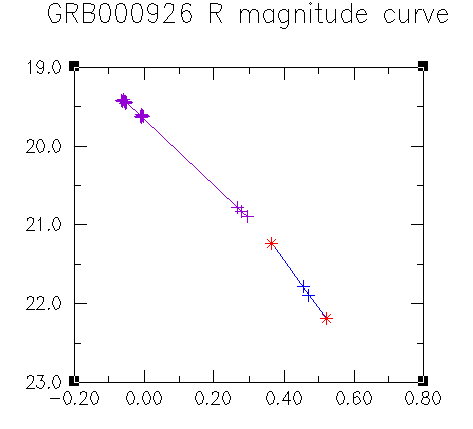
x axis is log(t-26.99) while t is in days since 2000 Sept. 0.0 UTC
|
TITLE: GCN GRB
OBSERVATION REPORT
NUMBER: 823
SUBJECT: GRB000926 - Optical
observations
DATE:
00/09/30 21:14:00 GMT
FROM:
Christian Veillet at CFHT <veillet@cfht.hawaii.edu>
GRB000926 - Optical observations
The optical counterpart of GRB000926
has been observed using the
CFH12K CCD mosaic camera at
the prime focus of the 3.6-m CFH
Telescope.
One 600s exposure with moderate
seeing (image quality 0.8")
has been obtained and a preliminary
reduction using the reference
star of Halpern et al. (GCN
#806) with R=17.1 gives the following
measurement for GRB000926:
Sept. 30.3075 R = 22.19 +/- 0.06
Added to the R-band data points
used in the analysis by Hjorth et al.
(GCN #814), to the previous
CFHT observation and to the last data
by Fynbo et al. (GCN #820),
this new point confirms the change in decay
rate announced in GCN #820.
The decay value is now 2.44
+/- 0.07, using data past Sept 29.2, while
the decay is 1.67 +/- 0.04
with data prior to Sept 29.2.
A graph of the light curve in
R with the linear fits can be found at
http://www.cfht.hawaii.edu/~veillet/grb.html
D. Kocevski, D. Donovan and
G. Luppino are acknowledged for their
help in this observation.
This message may be cited.
September 29 (posted
on September 29)
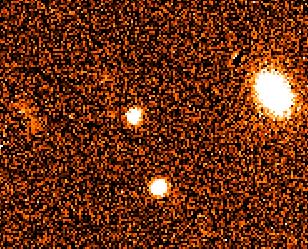
GRB000926 optical counterpart is shown here
|
TITLE: GCN GRB OBSERVATION REPORT
NUMBER: 818
SUBJECT: GRB000926 - Optical observations
DATE: 00/09/29 22:11:05
GMT
FROM: Christian Veillet
at CFHT <veillet@cfht.hawaii.edu>
GRB000926 - Optical observations
The optical counterpart of GRB000926
has been observed using the
CFH12K CCD mosaic camera at
the prime focus of the 3.6-m CFH
Telescope.
One 600s exposure with moderate
seeing (image quality between 0.9"
and 1.0") has been obtained
and a preliminary reduction using
the reference star of Halpern
et al. (GCN #806) with R=17.1 gives
the following measurement for
GRB000926:
Sept. 29.3075 R = 21.23 +/- 0.05
Added to the R-band data points
used in the analysis by Hjorth et al.
(GCN #814), this new point
confirms a pure power law decay with
a decay value of 1.69 +/- 0.03,
which is not significantly different
from Hjorth et al.'s determination.
An image of the area around
the GRB can be found at
http://www.cfht.hawaii.edu/~veillet/grb.html
Kocevski, Donovan and G. Luppino
are acknowledged for their help in
this observation.
This message may be cited.